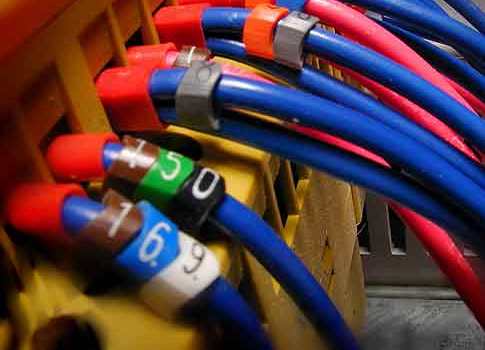Safety control systems have four typical architectures, each with advantages and disadvantages, and differing cost (per unit). See tables, photos.

According to the latest HSE reports [Health and Safety Executive is an independent U.K. watchdog group], each year 1 in 100,000 workers dies in a workplace accident. Another serious figure is that 1 in 125 workers will suffer a major injury preventing work for a week or longer. With almost 3 million people employed in the UK manufacturing sector alone, the impact of unreliable safety systems is obvious.
Industrial automation and increased production rates mean that many machines are bigger and faster than ever. Subsequently, the health and safety risks associated with any automated manufacturing process have risen too.
Increasing integrity and reliability of safety systems has been promoted in European law with the migration from EN954-1 to the latest SIL and Pl standards: ENISO13849 and IEC/EN62061.
For machine builders and owners, the ideal safety system architecture must conform with the minimum industry standards while allowing safe machine operation and not preventing operators from efficient production. The systems should be subject to a lifecycle cost analysis and a benefit-to-cost ratio analysis.
Many component manufacturers have, over the recent past, developed products specifically for use in safety-integrated systems.
Automation manufacturers that provide safety control equipment include:
- Pilz Safety
- Siemens
- GuardMaster (part of Rockwell Automation)
- Sick
- Schmersal
By their nature, machine safety systems are an understood element of most control applications and are tailored to meet safe machine operation requirements. Consequently, engineers need flexibility in the product suite they choose to meet the varying demands of individual machines.
Selecting safety components for inclusion in a safety system is subject to the same rigors as any design engineering exercise. They must, obviously, be fit for purpose, satisfy the technical (or safety integrity) demands of an application, and be cost competitive. (Safety is probably one of the areas where cost is the lower priority of the two). Technical and product support are, as always, in the mix.
This is the most basic safety system configuration with the cost per unit starting between £100 [~$158] and £300 [~$475].*
Option 1: Safety Relays
- All emergency stop buttons are wired in series (with dual channels for redundancy).
- Dual contactors are also used for redundancy.
- Reset circuit monitors contactors before allowing reset to occur.
Safety relays: Advantages, disadvantages
|
Advantages of safety relays |
Disadvantages of safety relays |
|
Cheap compared to other alternatives |
Wiring can be complex on big systems. |
|
Simple |
Difficult to commission and fault find when the system is down. |
|
No software programming required |
Complete rewiring is required if changes need to be made later. |
Option 2: Configurable safety relays
A safety control system employing configurable safety relays is slightly more expensive if installed on small systems. Typical price per unit is between £300 [~$475] and £1000 [~$1582].*
- Components are wired individually, making testing easier.
- Again, dual contactors are used for redundancy.
- Reset point is configurable in the software, in this case.
Configurable safety relays: Advantages, disadvantages
|
Advantages of configurable safety relays |
Disadvantages of configurable safety relays |
|
Configurable, flexible |
More expensive if used on small systems |
|
Easy to fault find |
Need for a PC and software to program |
|
Cheaper on large system due to saving on test time. |
– |
|
Easier to change |
– |
Option 3: Redundant PLC arrangement
A typical arrangement for programmable logic (PLC) controllers used in critical applications is to configure a redundant pair, often with "hot-swap" functionality. The redundant controller is used to support a safe and orderly shutdown in the event the primary controller fails.
Arranging multiple controllers and meeting the demand of a safety/critical application using standard PLCs involves cross-coupling additional, dedicated I/O from each PLC to monitor their individual conditions and initiate the “hot swap” routine in the event of a unit failure. In a nutshell this often proves to be a complex and time-consuming arrangement to design and implement.
Hence, designing safety systems with standard controllers at the core requires extended engineering time, hardware, and build time to implement the safety section of an application.
Rockwell, Siemens, and other major PLC manufacturers offer equipment specifically designed for these critical applications which, while carrying higher hardware costs, reduce the costs of design, hardware, and build activities and provide a certified solution to the application engineer.
The price for two parallel PLC systems starts around £10 000 [~$15,822], without considering other significant costs, such as software engineering and commissioning.
Option 4: Safety PLCs
- Specific code for safety applications is written in addition to the normal PLC code.
- Safe I/O modules can be centralized or remote.
- At present, safety PLC technology is more readily available and cheaper (from £2000 [~$3,164]* per unit)
Safety PLCs: Advantages, disadvantages
|
Advantages of safety PLCs |
Disadvantages of safety PLCs |
|
Very flexible |
More difficult to program |
|
Perfect solution for large machines |
Expensive software required |
|
Easy to expand later |
Understanding of PLC code is required and highly trained engineers required
|
* Prices cover hardware only; no engineering time is taken into account.
Examples: 3 safety control system projects
Safety control system project details show how the options above were implemented with laminating line redundancy, a machine retrofit, and an upgrade of a safety control system.
— Laminating line redundancy: Recently Optima designed and installed a safety control system for API’s Laminating line in Poynton, UK. Optima replaced the single channel emergency stop push buttons and guards with a dual-circuit system. Six new lockable guard switches were fitted on the machine.
A safety “motion detection system” was included using star wheel plates and rotation detection proximity switches fitted on two dc motor-driven rollers. The redundant safety system was designed to ensure that if one contactor failed to open and remove the mains supply, a backup contactor would ensure the supply is removed.
Designing machine safety systems needs take into consideration machine operability. Use of a programmable safety PLC (Pilz) provided machine operators with the flexibility to enter some sections of the machine, for thread up, etc., without compromising the integrity of the machine safety circuit.
API’s engineering manager Tony Robinson noted that Optima did a “high-quality job, on time, and within budget.” API used Optima previously and expects to use them again.
— Machine retrofit: In another equally safety-critical application at Dunlop Oil & Marine in Grimsby, UK, Optima engineers were to refurbish one of its main production machines to improve its control and reliability, and to meet the stricter safety standard of EN13849.
The project required that Optima’s engineers work closely with their Dunlop counterparts to design a complex, yet flexible, safety system, which could also monitor the rate of motion under various operational conditions. To successfully meet these demands, Optima selected the Pilz PNOZ Multiprogrammable safety relay to enhance the security of the machine and extend its lifetime. It also used Siemens’ Simotion D drive to precisely gear-lock the machine’s carriage drive, which applies the material to the main drive. Optima’s managing director Michael Hill explained: “By using the latest Siemens and Pilz technology, we have successfully enhanced the safety, security, and lifetime of Dunlop’s machine, therefore eliminating a major risk factor.”
— Safety control system upgrade: Another business for which Optima upgraded a safety control system was the papermaking, coating, and converting company Tullis Russell in Scotland. For this safety project, Optima integrated a Siemens PLC and HMI, Parker Hannifan SSD drives, ABB tension control, Pilz safety equipment, and Sick optics, subsequently elevating the machine’s productivity. The emergency stop system was designed to suit a risk level SIL2. A Pilz PNOZ multiprogrammable safety relay system was also used for this application. Hill from Optima said: “When considering a control system upgrade, safety improvements are unavoidable and are a fundamental component that keeps the machine running.”
– Ian Brady is a senior engineer at Optima Control Solutions Ltd., Blackburn, and is a TÜV functional safety certified engineer (CFSE). Edited by Mark T. Hoske, content manager CFE Media, Control Engineering, Plant Engineering, and Consulting-Specifying Engineer. Hoske can be reached at [email protected].
ONLINE extra
About the author: Ian Brady is a senior engineer at Optima Control Solutions Ltd., Blackburn, UK. As a TÜV functional safety certified engineer, he supervises many safety control system projects for Optima.
Optima Control Solutions designs, builds, and commissions drive control systems, including safety-related control systems. The company has grown steadily since its start in 1995, and serves clients in the UK and overseas, including customers in Europe, China, and South Africa. Industries served include paper, plastics, and metals.
ONLINE
https://www.controleng.com/safety
Optima: Optima Control Solutions – Industrial Automation Control Safety Upgrades Web Control



